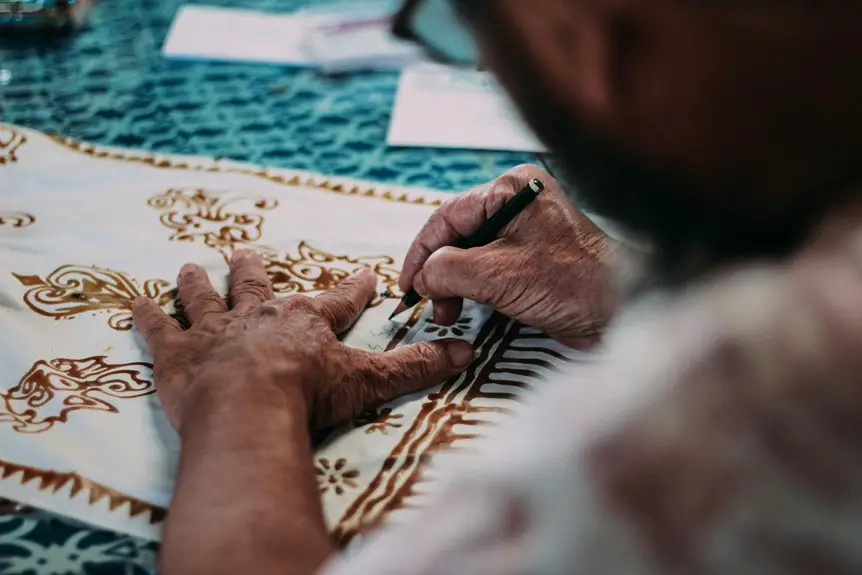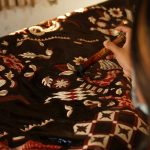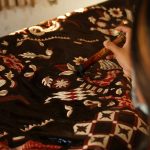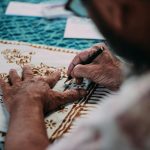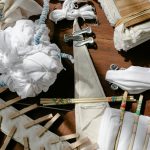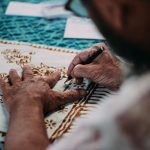To batik with Dye-na-flow fabric colors, start by choosing a natural fiber fabric and pre-washing it to prep for vibrant absorption. Use glue or masking fluid as a wax alternative to create resist patterns. Mix and apply the dye with brushes or sponges, allowing colors to flow within your design boundaries. Let your fabric air dry completely, then heat-set with an iron to lock in colors. Keep your tools clean for lasting use. You’ll find helpful tips and techniques ahead to perfect your project.
Table of Contents
Key Takeaways
- Pre-wash natural fiber fabric and stretch it flat for even Dye-na-flow dye absorption and vibrant colors.
- Use glue or masking fluid as a wax alternative to create resist patterns for batik designs.
- Apply Dye-na-flow colors with brushes or sponges, blending and layering for rich, transparent effects.
- Secure stencils firmly and apply dye in thin layers to avoid bleeding and achieve crisp batik patterns.
- Air dry fabric fully, then heat-set with an iron on the reverse side to fix colors permanently.
Understanding Dye-na-flow Fabric Colors
Before you begin your batik project, it’s important to understand how Dye-na-flow fabric colors work. These water-based dyes are designed to penetrate fabric fibers deeply, giving you vibrant, long-lasting colors.
You’ll find they flow smoothly and blend easily, which helps when creating gradients or detailed designs. Unlike traditional dyes, Dye-na-flow doesn’t require heat setting; air drying and a simple iron fix will do.
Keep in mind, these colors are highly concentrated, so a little goes a long way. Also, they’re transparent, allowing you to layer shades for richer effects.
Because they’re water-based, you’ll want to work quickly to prevent unwanted bleeding. When you grasp these basics, you’re set to create stunning batik art with ease and precision.
Essential Materials for Dye-na-flow Batik
To get started with Dye-na-flow batik, you’ll need to pick the right fabric that absorbs the colors well.
Make certain you have all the essential tools on hand, like brushes and wax applicators, to create your designs smoothly.
Finally, choose your Dye-na-flow colors carefully to guarantee vibrant and lasting results.
Fabric Choices Explained
Although Dye-na-flow fabric colors work beautifully on various textiles, choosing the right fabric is crucial for achieving vibrant, long-lasting results. Natural fibers like cotton, silk, and rayon absorb dye better, enhancing color intensity and detail in your batik designs. Synthetic fabrics may resist dye or produce muted colors.
| Fabric Type | Dye-na-flow Performance |
|---|---|
| Cotton | Excellent absorption, bright colors |
| Silk | Smooth finish, vibrant hues |
| Rayon | Soft texture, rich saturation |
Avoid heavily treated or blended fabrics as they can hinder dye penetration, leading to uneven patterns. By selecting proper fabric, you guarantee your batik art shines with clarity and brilliance.
Required Tools Overview
When working with Dye-na-flow fabric colors, having the right tools makes all the difference in creating clean, detailed batik designs.
To get started, you’ll want to gather a few essential materials that help you control the dye and achieve crisp patterns.
- Wax applicator (tjanting or brush): This lets you apply hot wax precisely, protecting areas from dye and defining your design.
- Heat source: A stove or electric wax pot keeps your wax melted and at the perfect temperature for smooth application.
- Protective gloves and workspace cover: These keep your hands and surfaces clean from dye stains and prevent accidents.
With these tools ready, you’re set to explore the beautiful art of batik using Dye-na-flow colors effectively.
Dye-na-flow Color Selection
With your tools in place, the next step involves choosing the right Dye-na-flow colors to bring your batik design to life.
Select vibrant, high-quality colors that suit your fabric type and artistic vision. Dye-na-flow offers a variety of shades, from bold primaries to subtle pastels, so pick colors that complement each other and enhance your pattern.
Consider how colors will blend or contrast when applied side by side. Remember, these fabric paints are transparent, so layering can create unique effects.
Start with a small palette to practice mixing and application before expanding. Also, test colors on a scrap piece of fabric to see their true appearance after drying.
Thoughtful color selection guarantees your batik piece will be vivid and visually striking.
Preparing Your Fabric for Dye-na-flow Batik
Before you start applying Dye-na-flow colors, you need to prepare your fabric properly to secure vibrant, lasting results.
Begin by choosing a natural fiber fabric like cotton, silk, or rayon, as synthetic fabrics won’t absorb the dye well. Next, wash your fabric thoroughly to remove sizing, oils, and dirt that can interfere with dye absorption. Avoid using fabric softeners during this wash.
Follow these steps to prep your fabric:
- Pre-wash the fabric in warm water with a mild detergent.
- Rinse thoroughly to remove any detergent residue.
- Lay the fabric flat or stretch it on a frame to keep it taut and smooth for dye application.
Proper preparation secures your Dye-na-flow colors penetrate evenly and stay vivid over time.
Creating Resist Patterns Without Wax
You don’t have to use wax to create resist patterns in your batik projects.
Try alternatives like glue, masking fluid, or tape to block areas from dye.
Experiment with different dye application techniques to achieve unique effects without wax.
Alternatives to Wax Resist
Although traditional batik relies on wax to create resist patterns, you can achieve similar effects using alternative methods that are easier to manage and clean up.
These options work well with Dye-na-flow fabric colors and let you experiment without melting wax or dealing with hot tools. Here are three effective wax alternatives:
- Glue Resist – Use clear-drying fabric glue to draw your design. Once dry, it resists dye and peels off easily after coloring.
- Frisket Film – A removable masking film that you apply to fabric, cut, and peel away after dyeing to reveal crisp patterns.
- Rubber Cement – Apply with a brush to create resist lines. It removes cleanly once dry, leaving your dyed fabric intact.
Try these methods to simplify your batik process and still get beautiful, vibrant patterns.
Techniques for Dye Application
Exploring alternatives to wax resist opens up new ways to apply dye with Dye-na-flow fabric colors.
You can use masking fluid or frisket to create crisp patterns—simply brush it on areas you want to keep dye-free, let it dry, then apply your colors.
Another technique is using tape as a resist; apply it to your fabric to block dye in specific shapes.
For a more organic look, try salt sprinkling on wet dye—it resists moisture, creating interesting textures.
You can also use stencils for precise designs; place them on fabric, then dab or spray dye over.
Mixing and Applying Dye-na-flow Colors
Several techniques make mixing and applying Dye-na-flow colors both easy and effective. When you start, keep these steps in mind:
- Mixing: Use a plastic palette or small containers to blend colors. Add water gradually to achieve the desired consistency—too much water weakens the color, too little makes it hard to flow.
- Application Tools: Choose brushes, droppers, or sponges based on your design. Brushes are great for detailed work, droppers for controlled spots, and sponges for texture.
- Applying: Work on pre-waxed fabric to prevent dye from spreading uncontrollably. Apply colors carefully, letting them flow naturally within waxed boundaries.
Techniques for Blending and Layering Colors
Blending and layering colors with Dye-na-flow fabric paints lets you create rich, dynamic effects on your batik projects. Start by applying a light base color, then work wet-on-wet to blend hues smoothly. For layering, let each layer dry before adding the next to maintain vibrancy and avoid muddiness. Use gentle strokes or sponges to control transitions. Experiment with overlapping colors to achieve depth and texture.
| Emotion | Technique | Effect |
|---|---|---|
| Excitement | Wet-on-wet blending | Smooth color gradients |
| Calm | Soft layering | Subtle depth |
| Creativity | Overlapping layers | Textured richness |
| Satisfaction | Controlled strokes | Precise color control |
Master these techniques to bring your batik art alive with Dye-na-flow’s vivid palette.
Using Stencils and Templates With Dye-Na-Flow
Using stencils and templates with Dye-na-flow fabric colors lets you add sharp, detailed designs to your batik projects quickly and easily.
To get started, first secure your stencil or template firmly on the fabric to prevent any movement. Then, apply the Dye-na-flow colors with a sponge, brush, or spray bottle for controlled coverage.
Here’s a simple process to follow:
- Choose a stencil with clean edges for crisp patterns.
- Apply dye in thin layers to avoid bleeding under the stencil.
- Carefully lift the stencil straight up to maintain design integrity.
This method lets you replicate intricate motifs effortlessly, enhancing your batik’s visual appeal without complicated freehand painting.
Drying and Setting Your Dye-na-flow Batik
After applying your dye with stencils or templates, you’ll want to confirm your design sets properly to maintain its vibrancy and detail.
First, let your fabric air dry completely in a well-ventilated area, avoiding direct sunlight to prevent fading.
Allow your fabric to air dry fully in a shaded, ventilated space to preserve your colors.
Once dry, heat-set the dye to confirm permanence; you can do this by ironing the fabric on the reverse side using a cotton setting without steam for about 3-5 minutes.
Alternatively, you might place a pressing cloth over the design and iron it directly. This heat activates the dye’s bonding properties, securing the colors.
After heat-setting, allow the fabric to cool fully before handling.
Proper drying and setting protect your batik design from washing out or bleeding, keeping your artwork crisp and vibrant for years to come.
Tips for Cleaning Up and Maintaining Your Tools
Ensuring your tools stay in good condition starts with thorough cleaning right after your batik session.
Residual dye can harden and damage brushes, tjanting tools, and containers if left unattended.
Follow these tips to maintain your equipment:
- Rinse tools immediately with warm water to remove excess dye before it dries.
- Use mild soap and a soft brush to clean stubborn dye from brushes and tjanting spouts gently.
- Dry all tools completely with a clean cloth or air dry to prevent rust and mold.
Troubleshooting Common Dye-na-flow Batik Issues
Although working with Dye-na-flow fabric colors is straightforward, you might encounter some common issues like uneven color flow, bleeding, or fading.
If colors bleed, make sure your fabric is completely dry before applying wax; moisture causes dyes to spread. For uneven flow, thin your dye slightly with water to improve consistency. Avoid applying too much dye at once, which can cause blotching.
To prevent fading, always heat-set your finished piece with an iron or dryer as per the dye’s instructions. If colors appear dull, check that you’re using the right fabric type; natural fibers absorb dye better than synthetics.
Finally, always test your colors on scrap fabric before committing to your design to avoid surprises.
Frequently Asked Questions
Can Dye-Na-Flow Colors Be Used on Non-Cotton Fabrics?
You can use Dye-na-flow colors on non-cotton fabrics, but results vary. They work best on natural fibers like silk or rayon. Just remember to test a small area first to guarantee good color absorption.
Are Dye-Na-Flow Colors Safe for Children’s Projects?
You’ll find Dye-na-flow colors are generally safe for children’s projects since they’re non-toxic and water-based. Still, you should supervise kids closely and use protective clothing to avoid stains and accidental ingestion.
How Long Do Finished Dye-Na-Flow Batik Pieces Last?
Did you know fabric art can last over 50 years with proper care? Your finished Dye-na-flow batik pieces can maintain vibrant colors for decades if you wash them gently and avoid prolonged sun exposure.
Can I Mix Dye-Na-Flow With Other Fabric Paints?
You can mix Dye-na-flow with other fabric paints, but test first to verify compatibility. Some paints might alter texture or color vibrancy. Always do a small sample to see how they blend before committing.
What Is the Best Way to Store Leftover Dye-Na-Flow Colors?
Think of your leftover Dye-na-flow as captured rainbows—seal them tightly in airtight containers or bottles, store them away from sunlight and heat, and you’ll keep their vibrant spirit ready to dance on fabric again.
- Using Crepe Fabric for Home Decor: Curtains, Pillow Covers, and More - June 23, 2025
- 5 Stunning Bridesmaid Dress Ideas Using Crepe Fabric - June 23, 2025
- Is Crepe Fabric Formal? How to Dress It Up or Down - June 23, 2025

